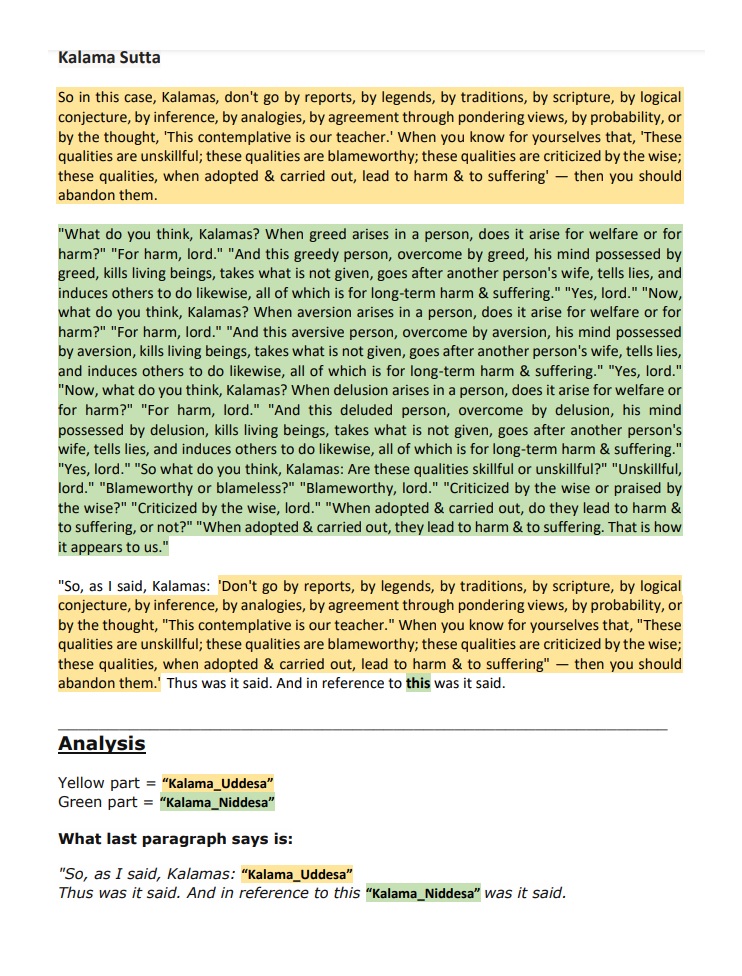The famous Sri Lankan lay Dhamma-preacher Saminda Ranasingha (aathaapi.org) insists on two points when he is explaining Kālāma sutta.
-
Kālāma sutta is only to be applied for Non-Buddhists
-
Kālāma sutta is only to be applied for Lobha-dosa-moha
(and Alobha-adosa-amoha)
I’m here going to introduce the 2nd point of him, for seeing your comments.
Kālāmā Sutta Analysis.pdf (116.1 KB)

Rest part of the sutta is also evaluated in the same way by him.
So he insists that Kālāmā Sutta can not be applied for evaluating other things mentioned in the Tipitaka.
If we consider the phrasing-style of the last paragraph in the above mentioned page:
“Iti kho, kālāmā, yaṃ taṃ avocumhā – … iti yaṃ taṃ vuttaṃ, idametaṃ paṭicca vuttaṃ.
So, as I said, kalamas – … Thus was it said. And in reference to this was it said.
This style can be seen in many Suttas in Anguttara nikaya and Majjima nikaya where,
- An “Uddesa (recitation passage)” is introduced first.
- Then it is questioned why was it mentioned. (in most cases)
- Then the Niddesa (explanation of the Uddesa) is menioned.
- At the end, it is concluded that the above Uddesa was mentioned for Niddesa.
Eg: Sakkapañhasutta, Araṇavibhaṅgasutta, Saḷāyatanavibhaṅgasutta, Dutiyasaññāsutta, Paṭhamamahāpañhāsutta, Titthāyatanādisutta … etc.
Saḷāyatanavibhaṅgasutta:
“‘Cha ajjhattikāni āyatanāni veditabbāni, …’ti – ayamuddeso saḷāyatanavibhaṅgassa.
“‘Cha ajjhattikāni āyatanāni veditabbānī’ti – iti kho panetaṃ vuttaṃ. Kiñcetaṃ paṭicca vuttaṃ? ‘Cakkhāyatanaṃ sotāyatanaṃ ghānāyatanaṃ jivhāyatanaṃ kāyāyatanaṃ manāyatanaṃ.
Cha ajjhattikāni āyatanāni veditabbānī’ti – iti yaṃ taṃ vuttaṃ idametaṃ paṭicca vuttaṃ.“‘The six interior sense fields should be understood. …’ This is the recitation passage for the analysis of the six sense fields.
‘The six interior sense fields should be understood.’ – That’s what I said, but why did I say it?
There are the sense fields of the eye, ear, nose, tongue, body, and mind.
‘The six interior sense fields should be understood.’ – That’s what I said, and this is why I said it.
Araṇavibhaṅgasutta:
“Na kāmasukhamanuyuñjeyya hīnaṃ gammaṃ pothujjanikaṃ anariyaṃ anatthasaṃhitaṃ, na ca attakilamathānuyogamanuyuñjeyya dukkhaṃ anariyaṃ anatthasaṃhitaṃ. … – ayamuddeso araṇavibhaṅgassa.“‘na kāmasukhamanuyuñjeyya hīnaṃ gammaṃ pothujjanikaṃ anariyaṃ anatthasaṃhitaṃ, na ca attakilamathānuyogamanuyuñjeyya dukkhaṃ anariyaṃ anatthasaṃhita’nti – iti kho panetaṃ vuttaṃ; kiñcetaṃ paṭicca vuttaṃ?
Yo kāmapaṭisandhisukhino somanassānuyogo hīno gammo pothujjaniko anariyo anatthasaṃhito, sadukkho eso dhammo saupaghāto saupāyāso sapariḷāho; micchāpaṭipadā. Yo kāmapaṭisandhisukhino somanassānuyogaṃ ananuyogo hīnaṃ gammaṃ pothujjanikaṃ anariyaṃ anatthasaṃhitaṃ, adukkho eso dhammo anupaghāto anupāyāso apariḷāho; sammāpaṭipadā. Yo attakilamathānuyogo dukkho anariyo anatthasaṃhito, sadukkho eso dhammo saupaghāto saupāyāso sapariḷāho; micchāpaṭipadā. Yo attakilamathānuyogaṃ ananuyogo dukkhaṃ anariyaṃ anatthasaṃhitaṃ, adukkho eso dhammo anupaghāto anupāyāso apariḷāho; sammāpaṭipadā.
‘Na kāmasukhamanuyuñjeyya hīnaṃ gammaṃ pothujjanikaṃ anariyaṃ anatthasaṃhitaṃ, na ca attakilamathānuyogaṃ anuyuñjeyya dukkhaṃ anariyaṃ anatthasaṃhita’nti – iti yaṃ taṃ vuttaṃ idametaṃ paṭicca vuttaṃ.
“Don’t indulge in sensual pleasures, which are low, crude, ordinary, ignoble, and pointless. And don’t indulge in self-mortification, which is painful, ignoble, and pointless… This is the recitation passage for the analysis of non-conflict.
‘Don’t indulge in sensual pleasures, which are low, crude, ordinary, ignoble, and pointless. And don’t indulge in self-mortification, which is painful, ignoble, and pointless.’ That’s what I said, but why did I say it?
Pleasure linked to sensuality is low, crude, ordinary, ignoble, and pointless. Indulging in such happiness is a principle beset by pain, harm, stress, and fever, and it is the wrong way. Breaking off such indulgence is a principle free of pain, harm, stress, and fever, and it is the right way. Indulging in self-mortification is painful, ignoble, and pointless. It is a principle beset by pain, harm, stress, and fever, and it is the wrong way. Breaking off such indulgence is a principle free of pain, harm, stress, and fever, and it is the right way.
‘Don’t indulge in sensual pleasures, which are low, crude, ordinary, ignoble, and pointless. And don’t indulge in self-mortification, which is painful, ignoble, and pointless.’ That’s what I said, and this is why I said it.